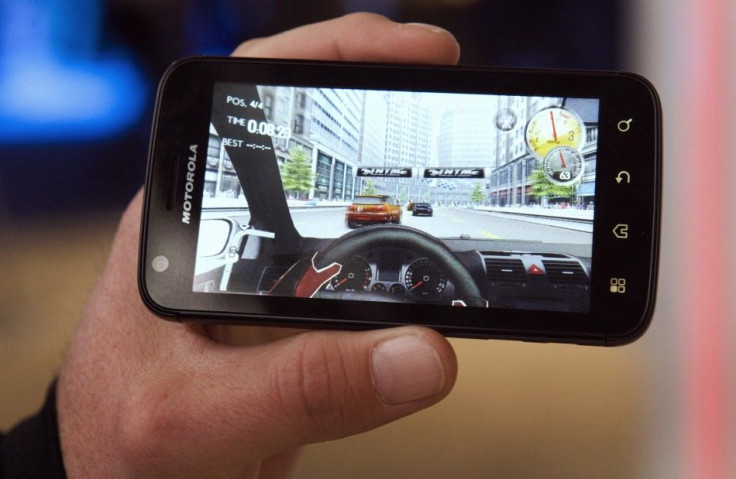AT&T’s Motorola Atrix 4G locks horns with Verizon’s HTC Thunderbolt 4G

The Motorola Atrix 4G has put some energy into mobile technology, as it is actually a laptop in the form of smartphone. The smartphone, which will be available on AT&T, has a docking ability which is not found in any other the smartphones in the market today.
On the other hand, HTC Thunderbolt 4G, which is going to Verizon, zooms past the competition with the LTE network. Both of these Android smartphones, powered by the Froyo operating system, are expected to make a splash in 2011. Here is spec comparison:
Size:
HTC Thunderbolt weighs in at 164 g and has dimensions of 122 x 66 x 13 mm, compared to Motorola's Atrix which weighs 136 g and is 117.8 x 63.5 x 10.1 mm.
Display:
The Atrix, with a 4-inch TFT capacitive touchscreen display has 540 x 960 pixels resolution whereas HTC Thunderbolt features a slightly larger 4.3-inch TFT capacitive touchscreen display with 480 x 800 pixels.
Input features:
The input features offered in Atrix are biometric fingerprint reader, touch sensitive controls, MOTOBLUR UI with live widgets, multi-touch input method, accelerometer sensor for UI auto rotate and proximity sensor for auto turn off. And Thunderbolt input features include an accelerometer sensor for auto rotate, proximity sensor for auto turn off, HTC Sense 2.0 and multi-touch input method.
Memory:
The memory capacity of Atrix is the highest offered by any other smartphone in the market with 1 GB RAM and has 16 GB internal storage. HTC’s Thunderbolt doesn’t fall far behind with 768 MB RAM along with 8 GB internal storage. And both these smartphones have microSD support up to 32 GB.
3G:
The 3G speed of Atrix is HSDPA up to 14.4 Mbps and HSUPA up to 5.76 Mbps whereas HTC’s smartphone offers Rev. A up to 3.1 Mbps. It also has LTE support.
WLAN/Bluetooth/USB:
Both these smartphones have Wi-Fi 802.11 b/g/n and DLNA support and come with Bluetooth version 2.1 with A2DP and EDR along with USB version 2.0.
Camera:
Motorola Atrix 4G has a 5 megapixel 2592?1944 pixel camera with autofocus, LED flash, geo-tagging, image stabilization that also captures 720p video at 30 frames per second. A 1080p update is expected in the future. The HTC Thunderbolt 4G features an 8 megapixel 3264x2448 camera with autofocus, dual-LED flash, geo-tagging, face detection and offers video capture at 720p. Both the smartphones have a secondary VGA camera.
Processor:
The dual-core 1GHz ARM Cortex-A9 ULP GeForce GPU Tegra 2 chipset processor in Atrix outmatches the HTC Thunderbolt’s 1GHz Scorpion Adreno 205 GPU Qualcomm MSM8655 Snapdragon processor.
Battery:
Motorola Atrix again outmatches the HTC Thunderbolt’s Li-Ion 1400 mAh battery with Lithium 1930 mAh which again is the highest capacity featured in a smartphone to date. Atrix offers a standby time up to 250 hours and 9 hours of talk time whereas HTC Thunderbolt is yet to be tested.
Price:
The Thunderbolt was originally advertised by Best Buy for $249 with a two-year contract, but now it's listed at $299 with the same deal. On the other hand Atrix 4G was priced at $149.99 but Wal-Mart offered the smartphone at $129.99 until Thursday.
Also, the Atrix 4G comes with HDMI support which is not found in the Thunderbolt 4G. The Motorola HD Multimedia Dock has three USB ports and an HDMI port enabling connections to a keyboard, mouse, speakers and HDMI-compatible monitor for working at your desk/office, or connecting to an HDMI-compatible television and home theater audio system for interacting with content and enjoying video, music, games and more in your living room.
And one of the main strengths of HTC Thunderbolt is its 4G network and HD capabilities. Thunderbolt combines the possibility of recording, sharing and viewing HD video. With the 4G LTE network customers can expect download speeds of 5 to 12 Mbps and upload speeds of 2 to 5 Mbps. And the smartphone can connect up to eight Wi-Fi devices.
© Copyright IBTimes 2024. All rights reserved.





















